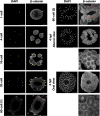β-Catenin localization in the ctenophore Mnemiopsis leidyi suggests an ancestral role in cell adhesion and nuclear function
- PMID: 39976308
- PMCID: PMC12412431
- DOI: 10.1002/dvdy.70004
β-Catenin localization in the ctenophore Mnemiopsis leidyi suggests an ancestral role in cell adhesion and nuclear function
Abstract
Background: The emergence of multicellularity in animals marks a pivotal evolutionary event, which was likely enabled by molecular innovations in the way cells adhere and communicate with one another. β-Catenin is significant to this transition due to its dual role as both a structural component in the cadherin-catenin complex and as a transcriptional coactivator involved in the Wnt/β-catenin signaling pathway. However, our knowledge of how this protein functions in ctenophores, one of the earliest diverging metazoans, is limited.
Results: To study β-catenin function in the ctenophore Mnemiopsis leidyi, we generated affinity-purified polyclonal antibodies targeting Mlβ-catenin. We then used this tool to observe β-catenin protein localization in developing Mnemiopsis embryos. In this article, we provide evidence of consistent β-catenin protein enrichment at cell-cell interfaces in Mnemiopsis embryos. Additionally, we found β-catenin enrichment in some nuclei, particularly restricted to the oral pole around the time of gastrulation. The Mlβ-catenin affinity-purified antibodies now provide us with a powerful reagent to study the ancestral functions of β-catenin in cell adhesion and transcriptional regulation.
Conclusions: The localization pattern of embryonic Mlβ-catenin suggests that this protein had an ancestral role in cell adhesion and may have a nuclear function as well.
Keywords: Wnt signaling; cellfate specification; cell‐adhesion; ctenophore; fate specification; mnemiopsis; β‐catenin.
© 2025 The Author(s). Developmental Dynamics published by Wiley Periodicals LLC on behalf of American Association for Anatomy.
Figures





References
MeSH terms
Substances
Grants and funding
LinkOut - more resources
Full Text Sources

